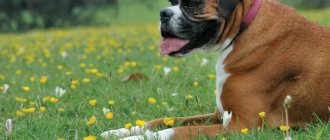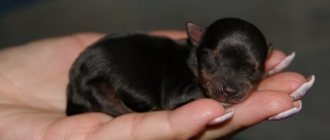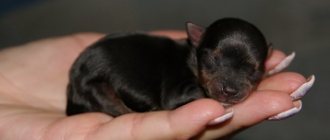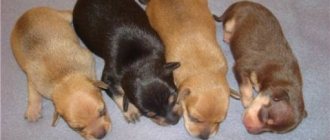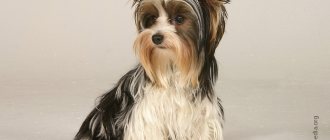Caring for a puppy at 1-2 months
If necessary, babies have their ears or tails docked in the first 2 weeks. This is due to the low pain threshold and rapid regeneration, which are lost within 4 weeks after birth.
Animals are breastfed until 2-2.5 months. Together with colostrum, maternal immunity is transmitted to them, so before switching to regular feeding, care must be taken to obtain all mandatory vaccinations.
First feeding
At the 3rd week of life, complementary foods are added to the diet: grated vegetables, slimy porridge and minced meat ground into a puree. Products with a high calcium content (cottage cheese, kefir) are introduced after 1.5 months. An alternative is special food for babies.
First vaccinations
At 2 months, the first vaccination against parainfluenza, infectious hepatitis, enteritis and leptospirosis is given. A little later, the baby is vaccinated against distemper and rabies. Sometimes they resort to a complex vaccine.
When to deworm
Before vaccinations, the dog is treated for parasites. You cannot use any folk remedies: horseradish, garlic, wormwood, etc. They are ineffective and can lead to poisoning. Therefore, it is worth buying a special drug from a veterinary pharmacy. It is advisable to choose products that are intended specifically for children, otherwise adult dosages will lead to poisoning.
The genuine medicine contains instructions for use.
The specific scheme depends on the product. For example, Milbemax is given at 2, 4 and 8 weeks, and Pirantel at 4-8-12 weeks. In any case, you should contact your veterinarian.
Moving a baby to a new home
Before your four-legged family member arrives, be sure to take care of safety. Remove all potentially dangerous objects from the floor, hide wires, insulate the trash can and protect the windows. After that, start purchasing the necessary things and direct adaptation.
Buying necessary things
The baby will need 2 bowls for food and water, grooming tools, ammunition, toys, absorbent diapers or a tray. Choose products made from durable and safe materials: ceramics and metal for bowls, nylon or tarpaulin for a collar. For small and medium-sized dogs, you can purchase a carrier.
Arrangement of the place
Arrange the sleeping place in the warmest room to avoid hypothermia of the four-legged one. Remove all carpets and install a small, spacious enclosure. With its help, you can limit the movement of your pet during your absence.
The place to sleep should not only be warm, but also comfortable and dry. If there are other animals in the house, make sure that each of them has their own personal bed or house. This will eliminate the occurrence of conflicts.
Adaptation to a new home
At first, the baby will miss his mother, so stay close to him and do not forbid him to sleep in the same room with you. To avoid aggression from other pets, limit the available space to only one room or enclosure. Let the other four-legged animals get used to the unfamiliar smell and only then introduce them to the little “recruit” face to face.
Exploring a new territory is best done under your supervision, right up to toilet training. Otherwise, the baby will definitely leave puddles.
Feeding
Immediately after the move, use the same food as the breeder. Switching too quickly to a new type of feeding can lead to digestive upset.
Mix new food into old food gradually, gradually increasing the amount of unfamiliar food. This may take up to 2 weeks, so take your time.
For comfortable development, babies need a lot of protein, calcium, unsaturated fatty acids and other useful elements. The recommended diet may vary depending on the breed, so be sure to consult your veterinarian to avoid vitamin deficiencies.
Upbringing
Stop permissiveness from the first days of the baby’s appearance in your home. Correct unwanted behavior and do not violate your own prohibitions.
Build your learning in a playful way, but don’t forget about firmness and perseverance. Otherwise, your authority will be undermined even before teenage stubbornness appears.
Try to choose a name as soon as possible and refer to your pet by name often. Smart kids can get used to the nickname in 1-2 weeks. Other brats will take about 3-4 weeks.
How to set up a sleeping area for a one-month-old puppy
How to care for a cat after castration on the first day
To make the adaptation period of a month-old puppy in a new home more comfortable, it is necessary to properly equip him with a place to sleep and take care of him. Dog handlers recommend relying on the following criteria when choosing and arranging a place:
- it should be comfortable and cozy, so you should not place it in a draft, near heating systems or places where household members constantly move. A small puppy should, when going on vacation, know that no one will disturb him and he will not have to constantly get up, making way for family members;
- the rug or bedding must be made of high-quality and non-staining material;
- If the owner decides to choose a bed in the form of a house, then he will need to take into account that the dog will grow, so there is no need to buy a product that exactly matches the size of the dog. However, buying a house that is too large is also not a good idea.
The sleeping place should be comfortable for the dog
Caring for puppies up to six months
Caring for a puppy from 2 to 6 months is no longer limited to feeding alone. After vaccination, the pet is accustomed to the street and begins to train.
First walk
Going outside becomes possible after quarantine. Until this moment, the dog is walked strictly in arms or in a closed area in the courtyard of a private house.
Quarantine lasts 2 weeks after the last mandatory vaccination. The thing is that the body takes a lot of effort to produce antibodies. During this period, the immune system is weakened and vulnerable to harmful microorganisms.
Before the first walk, be sure to teach your baby the equipment and basic commands. Remember that the tension on the leash must be stopped on both sides. The animal must walk on a loose leash close to its owner.
Feeding
The number of feedings and the diet itself depends on age. Up to 4 months the animal is fed 4-5 times a day, and from 4 to 6 months - 3-4 times a day. With natural nutrition, fresh cabbage and boiled sea fish are added to complementary foods. A puree-like consistency is welcome until all the molars appear.
For industrial feeding, ready-made food in the form of spiders or canned food is used, as well as dry granules soaked in warm water. All proportions are selected individually based on the weight, age and breed of the animal.
Please note that when switching to independent feeding, you must completely eliminate milk. As dogs get older, they develop lactose intolerance, which can lead to diarrhea and vomiting.
What skills should a dog master?
Proper care of a puppy includes training, accustoming to various hygiene procedures and wearing equipment. From 2 to 4 months, the pet must remember its name and place, learn to go to the toilet outside, and also get used to combing its fur, trimming its claws, and wearing a leash with a collar.
By six months, the list of skills is supplemented with the following commands:
- "To me";
- "Near";
- "Sit";
- "Lie";
- "Stand";
- "It is forbidden";
- "Ugh".
If during training serious problems arise that impede the acquisition of skills, sign up for courses at a canine club. For companion dogs, it will be enough to pass the UGS. For everyone else, OKD is more suitable, serving as the basis for more complex courses.
What should you wean your pet from?
The educational process is built not only on accustoming to something, but also on weaning off unwanted behavior. These include:
- Begging. Feed your dog at separate times and ignore any attempts to beg for food from your table.
- Chewing furniture, shoes and other objects. Use a special repellent spray and buy more chew toys.
- Picking up from the ground. Stop this behavior with the command “Fu” and walk with a muzzle until the four-legged dog learns to respond to it.
Please note that you must be at one with all family members. If one of your compassionate relatives periodically feeds the dog from his plate, your educational efforts will never yield results.
Revaccination
Revaccination, or re-vaccination, is carried out 21-28 days after the main one. Its main task is to increase the amount of antibodies necessary to protect the body.
Ensuring Healthy Potty Time
A healthy one-month-old puppy should eliminate waste on its own and attempt to clean itself. However, if you see that he is unable to go potty, you will need to encourage your little one to urinate and defecate after meals by wiping his genitals with a washcloth or cloth soaked in warm water. This is especially important to prevent constipation in puppies if they do not eliminate their stool regularly. As far as potty training goes, that won't start for a few weeks.
Caring for puppies up to 1 year old
Caring for puppies after six months means becoming familiar with the problems associated with puberty. During this period, the owner needs to think about castration or sterilization.
Puberty
Sexual maturity occurs at 6-8 months. At this age, the first estrus and the first sexual heat occur. The dog behaves more aggressively towards other males and shows increased interest in the opposite sex.
If you do not plan to participate in breeding, sign up your pet for surgery. It has a beneficial effect on the animal’s behavior and serves as a prevention of cancer pathologies.
Teenage stubbornness
Along with puberty comes stubbornness. Due to hormones, the pet becomes willful under any restrictions, trying to undermine the authority of the owner. He refuses to follow commands and often gets into fights with other animals.
The radical solution to the problems that have arisen is castration. In all other cases, you should be patient, since education and socialization will have to be dealt with from the very beginning.
Features of feeding
After six months the dog is switched to three meals a day, and after a year - to two meals a day. More protein is added to the diet in the form of raw or boiled meat and offal. There is no need to grind food anymore, as the pet has permanent teeth. If you use ready-made food, you can smoothly switch to an adult diet of the same brand that your four-legged eats.
Natural diet
When choosing a natural diet, the owner of a mongrel should not be in the mood for porridge. The dog's diet should include:
- dairy products (milk, curdled milk, cottage cheese, whey);
- meat products and bones (including offal);
- fish;
- eggs.
Dairy
If a puppy is weaned from its mother at the age of 1.5 months, then it can be safely offered all available dairy products.
When introducing fresh milk into your diet, you should monitor your digestion. For unformed fecal matter, it is better to switch to yogurt or kefir.
Milk is rich in:
- proteins;
- fats;
- fat-soluble vitamins;
- easily digestible minerals.
Fermented milk cheese is a storehouse of casein and calcium. Thanks to them, skeletal muscles and bones will develop well. For a growing body, they are as necessary as meat products.
Whey, which remains from making cottage cheese, does not have a high monetary value, but is a valuable source of minerals. If possible, it should be fed ad libitum.
Meat products
To feed a mongrel, there is no need to choose premium grade meat. You can give preference to offal. In this case, they must be alternated :
- pork trimmings;
- beef trimmings;
- beef tripe, and pig stomach, lungs, udder, kidneys;
- chicken giblets (gizzard, heart);
- chicken and turkey soup sets.
Wherever a meat product is purchased, it should be cooked, especially the offal. If salmonella enters the body, you may not have time to orient yourself and significantly undermine the puppy’s health, or even lose it altogether. Welding is carried out for at least 30 minutes from the moment of boiling. If the meat is wild boar, then it should be cooked for an hour.
Even a small puppy should have bones in his diet every day. Initially he will play and scratch his teeth. Some of the bones and cartilage tissue will enter the digestive tract and balance the diet in terms of minerals.
For a puppy, it is better to choose a spatula. In a young pig it is tender, with a cartilaginous top, so give preference to it. The puppy will not chew on large joints - this is wasted money. The dog quickly eats bones and remains full for a long time. If the puppy refuses to eat after eating bones, don’t force it.
Eggs
A balanced, natural product that nature has given to the animal world as food and medicine is eggs. Being a source of essential amino acids, vitamins (including vitamin U), and minerals, they must be present in the puppy’s diet.
Eggs should be washed before feeding the product. Salmonella does not live in the egg, but on the shell. It is enough to rinse them under running water and safely offer them raw to the puppy.
The only thing that can be dangerous about an egg is an allergy. It happens extremely rarely, but you need to pay attention to it. After feeding the egg, after a while examine the skin and mucous membranes. If everything is in order, then there is no point in denying the animal a quality product.
Fish
A puppy does not need a lot of fish, but it must be present in the diet. It is enough to buy cheap varieties of small fish (sprat, sprat) or herring, hake pollock and offer 30-40 g per day. This will balance the diet in terms of proteins, Omega-3 acids and minerals.
The fish is served boiled. The dice are not chosen. The broth is also fed to the puppy as a mineral-rich food.
If sea fish can be boiled for 15 minutes, then lake and river fish need to be boiled for at least 30 minutes. Boiling kills the larvae of helminthic infestations, but it also inactivates beneficial substances.
To reduce the cost of the fish component, you can purchase fish heads and ridges. Such a product is not expensive, and its value differs little from the fish itself.
Advantages of natural feeding
The products listed above are available. They are natural and natural to the carnivore. Even if you decide to feed the dog dry food, it is better to feed the puppy natural food.
By feeding one or another food into your diet, you can easily identify allergies or food intolerances and remove them from your diet.
With natural feeding you can easily:
- balance nutrients;
- independently carry out quality and quantity control;
- natural products carry “live” biologically active substances necessary for the body.
Flaw
In the modern world, when dry food appeared, one can consider the disadvantages of natural feeding, but before this could not even be discussed - there was no alternative.
For natural, balanced feeding, especially if food is purchased for future use, you need to:
- storage location (refrigerator, freezer);
- cooking utensils;
- time for preparing food;
- time to clean the feeding area and wash dishes.
The disadvantage is that the products perish quickly and it is necessary to constantly monitor their quality.
What both a puppy and an adult dog need
It is necessary to note several points that do not depend on age. These include hygiene, drinking regime, vaccinations and routine examinations, as well as treatment for parasites and regular walks.
Hygiene of eyes, ears and teeth
Caring for a puppy and an adult dog is not complete without periodic cleaning of the eyes, ears and teeth. Carry out an external inspection daily and watch for the appearance of foreign secretions.
Be sure to remove plaque that accumulates in the corners of the eyes and clean the ears from dirt using lotions or cotton pads.
Thorough teeth cleaning is carried out 1-4 times a month. To do this, use veterinary paste and a small toothbrush. The rest of the time, it is enough to give your pet special treats and chewing toys to prevent the formation of tartar.
Drinking regime
The average norm for dogs is 100 ml per 1 kg of weight per day. The exact amount depends on the size, age, gender and diet of the animal. Large young bitches on dry feeding require the most water, and small older males on natural food require the least amount of water.
Be sure to change the water in the bowl 1-2 times a day. If you use water straight from the tap, don't forget to filter it.
Vaccinations and routine health checks
After 1 year, all subsequent vaccinations are given 1-3 times a year, depending on the animal’s health. Routine health checks are equally important. They are carried out 1-2 times a year.
Treatment for parasites
Treat for internal parasites (worms) every six months, and for external parasites (ticks, fleas) during periods of maximum activity. It is better to entrust the choice of antiparasitic agents to a doctor. Due to their toxicity, it is very important to consider the age and health of the quadruped. The most gentle medications are selected for babies and pregnant females.
Life without a mother: nutrition from birth
When can you take your puppy outside for walks after the first vaccination?
Being close to its mother, the puppy, no matter whether it is a mongrel or a purebred individual, receives her milk, which contains all the useful substances and vitamins for proper development. But when moving to a new home, providing the food ration falls on the owner’s shoulders, because it should be no worse than what his mother fed the pet. Therefore, it is important to decide what the dog’s food will be - natural or industrial.
Note! Natural nutrition is based on fermented milk, meat products, and fiber. Industrial food includes the necessary amount of vitamins for adequate feeding of a puppy, and can be purchased at any store.
Is it possible to mix natural and industrial food?
Mixing natural and industrial food is strictly prohibited. Some owners do this to make the food more nutritious, but this action can cause serious harm to the pet's health.
The type of food must be selected by the owner, but they cannot be mixed
Aspects of education
Sometimes, with the best of intentions, new owners do too much to relieve the puppy from the stress of separation from its mother. This applies to being with the baby every minute, feeding in places not intended for eating, constantly being carried in arms and other things.
You should understand: the puppy will grow up, but the habits will remain.
The older the dog gets, the less affection his pranks cause, and over time, the dog still begins to instill good manners. Late socialization and learning the rules of behavior in the house are painful for animals and traumatic for the psyche.
Prioritization or who is boss in the house
In order for the puppy to learn from the first days the arrangements in the “pack”, where the leader will be a person, you need to adhere to some rules:
- Both the dog and the owner have the right to privacy. You cannot spend all your free time with the puppy - the puppy must be able to occupy itself. After playing with your pet, you should leave him alone and go about your business. You can defiantly ignore him for a while: the baby will calm down and stop bothering you.
- You need to teach your dog to stay home alone. You need to do this from the first day, going out the door for a few minutes. It is important that the puppy sees this happening and does not sleep during this time. Over time, the “care” intervals are increased, but no more than an hour in the first few days. During the period when the baby is left alone, he should be well-fed and play enough.
- From the first days, the puppy needs to arrange a place to rest and eat: he must learn to understand that the apartment is divided into certain zones, each with its own functionality. If the feeding place is chosen in the kitchen, it is wrong to expect that the dog will not subsequently go there whenever he wants.
- The dog eats after the owner. This is a very important rule, which subsequently eliminates many behavior problems, especially in “serious” dog breeds. The dog must see that the person (leader) is eating. This is the order of the pack among wild relatives, and domestic animals are no different genetically from them.
- The owner goes up the doors, openings, and stairs first. The puppy will not learn this rule from the first day, but from the moment training begins, you need to remember it, since it is included in the list of priorities.
Such aspects of education do not violate the norms of morality and morality, and the dog will not love its owner less if it learns them. Raising a puppy does not mean its humiliation or infringement of the animal's rights. It is aimed at comfortable coexistence between humans and dogs in society and is designed to ensure, in particular, the safety of people living with the pet.
Place training
Your puppy should have a place where he can feel safe and rest without worrying about someone stepping on him or kicking him out of the way. As a rule, dogs like special beds that are sold in pet stores, but you can also easily design them yourself. Small breeds of dogs are provided with houses, while very large dogs often do without bedding at all. The lounger is arranged in a non-accessible area of the apartment, away from drafts.
In addition to the rest function, the place for the dog has another purpose: it is a certain point where the puppy can be sent if he is in the way or gets naughty. Determining a place for a dog is very important: it increases self-esteem, since a smart owner respects not only his freedom, but also his dog’s personal space.
Teaching a puppy the “place” command is not difficult. At the moment when he has had enough of playing and has practically fallen asleep, he needs to be taken to the mat and told “place!” The command is also repeated during the puppy’s attempts to explore the bed. Fixing the location with a voice will be imprinted in the dog’s memory over time. You can accustom him to his place from 2 months.
Important: it is wrong to try to strengthen the team with food by placing treats on the bedding. The dog is not fed where it sleeps; conflicting commands can confuse the pet.
Toys
Like all children, puppies should have their own toys. Their presence is very significant:
- They protect things and objects in the apartment from destruction, because teething requires a product that can relieve the itching, and often without the opportunity to chew a tasty toy, puppies spoil clothes and furniture.
- Toys help brighten up the puppy's lonely hours when the owners are not at home.
- This is a great way to keep your pet in good physical shape and a means of training the mind: many modern toys are created specifically for this purpose.
Clothing for Chihuahua
Small dogs are more likely to catch colds due to hypothermia. You can minimize the problem by choosing clothes for your Chihuahua according to the season:
- in autumn and spring - sweaters, cardigans, waterproof overalls;
- in winter - insulated jacket and pants, scarf, socks, shoes;
- in summer - light-colored suits to protect against sunburn.
Shoes in winter not only protect paws from the cold, but also from reagents, licking which the dog gets an upset stomach or poisoning.
Preparations for the meeting
With the addition of a four-legged creature to the family, changes in the interior of the apartment are inevitable. When a little dog arrives in the house, you should prepare everything you will need for the first time:
- a set of bowls for food and drink;
- litter tray;
- grooming tools;
- outdoor accessories (leash, collar, overalls for the cold season);
- “chewing” elastic toys (with them the puppy will be able to “scratch” the gums, from which the first milk teeth will erupt);
- repellent spray, the smell of which will correct the behavior of the ward, who loves to gnaw and scratch everything.
You should build a cozy dog house for the new guest. A soft rug or mattress will cope with this role. The lounger should be in a warm and quiet place, away from medications, electrical wiring, piercing and cutting objects.
From the breeder you need to take not only documents confirming the dog’s pedigree, but also detailed information about the health and features of caring for the newborn. The following information will be helpful:
- what ailments afflicted the cub’s parents;
- how the birth proceeded - with or without complications;
- whether the breeder gave the puppy the first complementary foods and where he started;
- what kind of litter the dog is accustomed to;
- whether immunization was carried out, what vaccinations were given and when;
- when was the kitten dewormed for the first time, how much time passed after the last deworming.
It would be a good idea to get the veterinarian’s phone number in advance.
Meet the parents
If you know exactly what the puppy's mom and dad look like, it will be easier to guess its approximate size: small, medium or giant. At the same time, you need to understand that if the dogs were of different heights, the puppies will take after either their mother or their father. Therefore, a litter may contain both large and medium-sized dogs at once.
Often only the mother stays with newborns, so her size is taken into account. Female puppies will grow approximately as big as their mother, while male puppies will grow 15% larger. Also look at the puppies' initial height and weight. Small ones will develop gradually and grow to medium size, while large ones that stand out among their siblings will likely grow to be taller than average.
Prohibited Products
Man has come up with many tasty but harmful products. The dog should not consume:
- sausages and sausage products (both smoked and boiled);
- raw fish and fish products, especially from inland waters;
- fried products of any origin;
- sauces on any basis;
- flour products.
You can offer a sugar cube as a treat, but it is better to avoid sweets.
The mongrel should not be hungry, but excess calories in the diet can lead to weight gain, apathy and obesity. By observing an animal, you can easily determine the feeling of satiety and hunger. Take a closer look at your favorite, and she will tell you herself.


